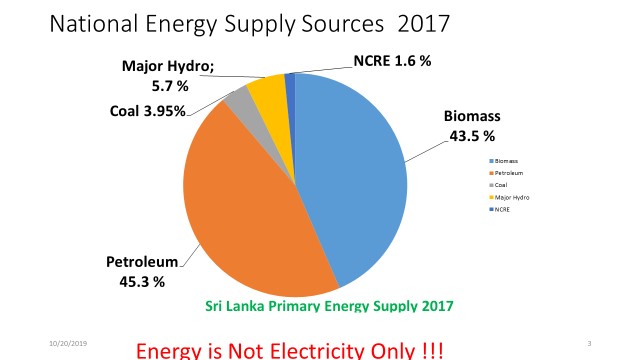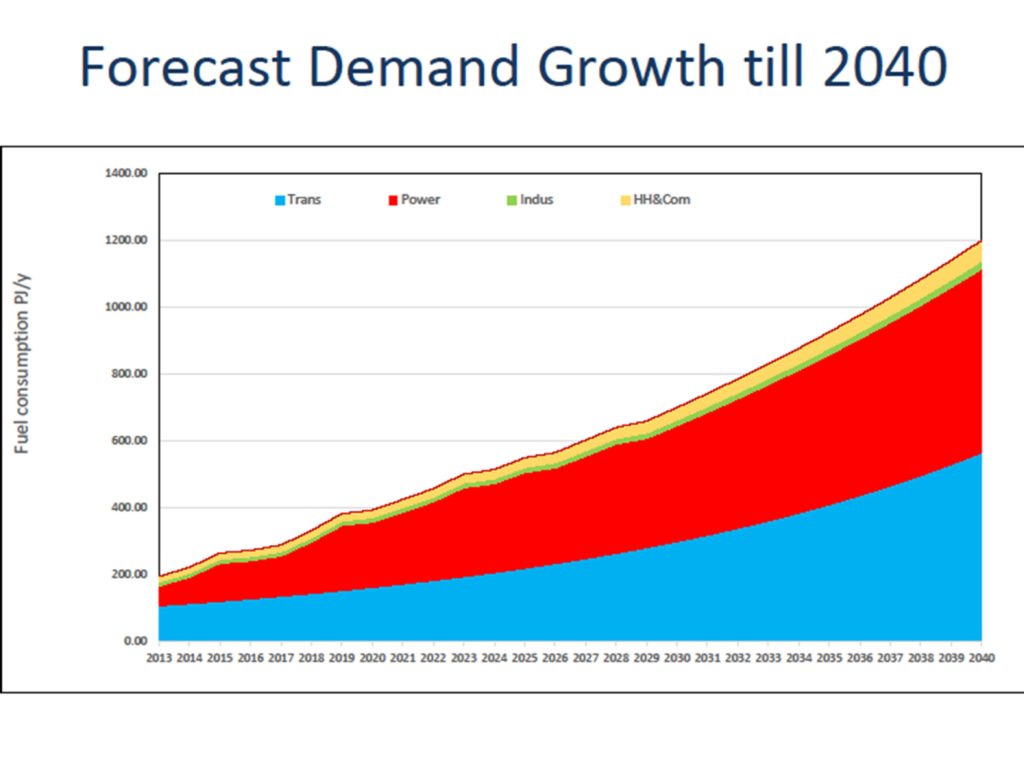A Pragmatic Vision on Future Energy Security for Sri Lanka
With the much awaited presidential election now over and the new president and a Cabinet in place, the country is agog to find the direction in which the country will be guided by them. The policy manifesto of His Excellency The President, has covered many important elements of the economy and the social fabric of the country which also covers the important aspect of energy.
While such policy manifestoes have been just words and empty promises, as has been the unfortunate experience of the citizens of Sri Lanka in the past there is much hope that the situation would be different as His Excellency President Gotabhaya Rajapakse has continually emphasized that he intends to ensure that all projections in the manifesto will be carried out within his tenure itself. His unblemished past performance gives much credence to this promise.
However, while many aspects such as national security, economic development, agriculture and social justice and many others have been the focus of these projections and promises, it is unfortunate that the focus on energy is less than adequate with no firm targets and policy directions. Very little, if any, comments have been included on the energy sector, security and development. The increased recognition and awareness worldwide on the ever increasing threat of Climate Change the negative impacts of which are increasingly felt by Sri Lanka as well. Sri Lanka cannot expect to ignore its global responsibilities by continuing the use of fossil fuels which is the major contributor to the global warming. In addition in the present context with Sri Lanka facing severe foreign exchange crisis and balance of payment problems, the severe drain of foreign exchange for the import of fossil fuels cannot be allowed to continue unchecked.
The importance of adequate and affordable supply of energy is imperative for the economic development does not need any elaboration. It is hoped that the government and the newly appointed Minster for Power and Energy appreciate this fact and have given serious thought on this important economic aspect in formulating their policies.
The current status
The energy sector presently made so dependent on imported fossil fuel both for electricity and transport mainly, has created grave negative impacts on the national economy as shown below. Sri Lanka spends over $ 4,000 Million annually on import of oil and coal at present. While the depressed oil prices in the past few years lowered this from over $ 6,000 Million spent in the early years of this decade, this would change adversely in the near future considering the very unsettled political conditions in the middle east. It is also necessary to recognize that the US $ 6,000 equated to only Rs 678 Billion in 2010, but the current bill of US $ 4,000 costs us Rs 728 Billion.
It is also unfortunate that electricity supply, both sources of supply, cost of generation and consumer tariff seems to have not received the careful attention of all past regimes. While electricity serves only about 10% of the national energy demand even now, it seems to receive 100% of the attention and all the other forms of energy which contribute the balance 90% of energy consumption receives scant attention and discussion.

Considering the present state of the electricity sector, totally controlled by the state owned monopoly, and the very direct and immediate impact it’s performance has on all the citizens, this sector does require focused attention and urgent corrective action. The CEB is forecast to make a loss of Rupees Hundred Billion in the year 2019, on top of the many billions lost over the past years.
Since it is imperative to keep the electrons flowing to keep the bulbs burning and motors running, the national economy will have to absorb this loss so that the CEB is kept afloat. It will however be the citizens of Sri Lanka who will have to grit their teeth and pay this colossal loss in some way or other, and not the Ministers of power or the engineers of the CEB or the officials of the Ministry who must accept the responsibility.
The outgoing Minister for Power and Renewable Energy shamelessly sought the Cabinet approval to increase the borrowing powers of the CEB by a further Rs 50 Billion. This is in order to ensure that the Petroleum Corporation would continue the supply of oil for electricity generation.
It is important to consider the wider impact of such continued and enhanced borrowings. All the current loans to the CEB ( or the vast majority of them ) have been provided by the two state banks. While no sane banker would continue to lend to such a pathetically bankrupt borrower, they would no doubt be forced by the government to provide this additional loan too.
Serious consideration is needed as to at what stage the tipping point would be reached by these two banks if this practice is continued, not forgetting the other bottomless pits such as the Sri Lankan Airlines which is continually kept afloat by the same banks.
The forecast for the future
Of the other forms of energy illustrated in the chart above, the largest segment is occupied by the transport sector, which is totally dependent on imported fossil fuels. While the economic impact on this total dependence is not directly felt by the populace, the obvious negative impact on the balance of payments and the parity rate is evident. This has an immediate impact on all segments of the economy and the cost of living of all citizens. And unless the outstanding payments from the CEB is settled, the CPC also would need to seek funding from the treasury to keep afloat.

In this background that the new President and the government which has to be formed, could no longer take an ostrich attitude, but must face reality. Electricity is no doubt the most desired form of energy and can serve all other demands for energy too, if correct policies are adopted and pursued. In this regard the firm commitment for rapid electrification of the transport sector is the most obvious. This policy is well established all over the world except in Sri Lanka which imposes punitive import duties on electric vehicles. Some countries have targeted 100% electrification of transport within the next decade itself. With this change the electricity sector can aim for a much larger contribution to the energy pie which is the national desire, and should be the aspiration of the state monopoly. On the other hand the consumers themselves have the option of saving both their electricity bill as well as the petrol bill as I have done myself, by the use of Solar PV to generate their full energy needs. The optimization of this scheme and clearing the road blocks for widespread adoption by the vehicle owners is the immediate responsibility of the new Minister for Power and Energy.
There are many other fundamental aspects with which the energy sector should be viewed and evaluated to formulate future energy policies and strategies. Such detailed presentation could be provided to any party interested in a logical approach to this important national issue. In the meanwhile only a brief summary of policy elements that we hope would be adopted by the government are listed below.
Proposed themes for a Future Energy Policy and Strategies
- Energy is not only electricity, which at present provides only 10-12 % of the primary energy demand. Therefore a holistic energy policy covering all forms of energy demand and supply shall be developed with high emphasis of maximizing the use of indigenous resources.
- The double advantage of decarbonizing the energy sector, the primary contributor to the ever increasing climate change impacts, even in the local scene, and the economic advantages to be gained by weaning away from imported energy resources, the target of achieving 100% RE at least by year 2040 will be pursued aggressively with challenging intermediate targets.
- Although Natural Gas has a relatively less negative impact on the environment and has greater flexibility of usage, which could have made it an attractive choice to be integrated to the national energy mix, there is complete lack of clarity as to how the natural gas is to be procured. In addition the widespread use of even imported LNG requires a complex infrastructure which cannot be put in place for many years and at great expense. The promise of natural gas form Mannar still remains elusive due to the world gas price dynamics and there is no indication of it being commercially exploited for many years to come. Thus much deeper and unbiased evaluation of the pros and cons of adopting Natural Gas as a viable component of the energy mix with long term viability is required.
- In particular it would be fool hardy for Sri Lanka to think of using Natural Gas as a replacement of petrol and diesel in transport. This is particularly so due to the lack of any certainty of the source of supply as well as the lack of infrastructure. On the other hand, why continue the use of the Internal Combustion engine with an overall efficiency of only 25-30% when an electric vehicle operates at near 90% efficiency in addition to many other advantages.
- No more coal power plants should be planned or implemented. The Norochcholai coal power plant should be made 100% compliant with the environmental and other regulations within one year and should be managed to provide the maximum return on the heavy expenditure already incurred.
- Surya Bala Sangraamaya on roof top Solar PV should be strengthened with the achievement of the initial target of 1,000 MW by 2025 and expanded to reach the One Million Households by 2030. Incentivized tariff system will be introduced to encourage householders to add storage batteries to enhance the utility of the systems in to the night time peak hours. For this purpose the present punitive duties and other levies imposed on deep cycle batteries need to be relaxed.
- Solar Parks of capacity over 5 MW to benefit from economies of scale and to encourage local investors will be encouraged by fast track approvals and support from the utilities and transparent and pragmatic tender procedures and quick awards. Additional tariff systems should be introduced to add adequately sized battery storage systems. The use of the substantial number of irrigation tanks for floating solar PV parks is a natural option for the expansion of the utilization of the solar energy resource that the mother nature has bestowed on Sri Lanka. This would also eliminate the objections for use of lands for large scale solar parks. The necessary technologies are already available and the added advantages of floating solar PV are well recognized.
- Ensure the development of 1,000 MW of dendro (biomass) power by providing access to lands for energy plantations by the developers and facilitate the monetizing of the value of Gliricidia leaves as a fodder and fertilizer. Thus would maximize the overall benefits to encourage the expansion of planting by householders and small farmers, creating a vibrant rural economy linked to energy. Each 10 MW dendro power plant will infuse Rs. 500,000,000 annually to the rural economy by the sale of fuel wood alone.
- The transport sector totally dependent on imported oil is a severe drain on foreign exchange. Therefore rapid conversion to electric vehicles is to be undertaken with removal of all import duties and other levies on electric vehicles. A target of 25% of all new registrations by 2025 and 50% by 2030 to be set for both privately owned vehicles and public transport vehicles.
- The already planned electrification of the railway form Veyangoda to Panadura will be implemented urgently. The scope of electrification to be expanded to other segments of the railway after due study.
- Challenging targets to be set of demand side management of all forms of energy, with incentives provided for achieving a target of 20% savings by 2025 on electricity. All new building approvals to meet the mandatory energy efficiency targets set by the SLSEA.
- The role of the PUCSL as the regulator for electricity, petroleum and water to be strengthened by providing total independence and mandatory compliance by the responsive utilities and other service providers.
- The achievement of the targets for decarbonization and integration of RE to the national grid should be the responsibility of the Utility and the SLSEA. The mandate for removal of barriers and harnessing the support of private sector investors and developers should be given to the utility.
- The investments of private sector for all forms of energy investments will be attracted by totally transparent tender systems and transparently predetermined feed in tariff system, where applicable and needed to reach early maturity of an indigenous energy industry.
- The Concept of “ProSumers” where the consumers themselves will also be power producers should be encouraged in order that the energy industry is democratized not limited to a small number of large investors local or foreign.
Some of the above proposals can be implemented immediately under the prevailing laws and regulations. For example the Surya Bala Sangraamaya has contributed over 200 MW of additional energy to the grid in a short period and can easily attain the set targets well ahead of time targets set. It has the greatest advantage of total investment by the private sector with no burden on the state treasury. However a firm long term national energy policy, not limited to electricity is an urgent and essential need to ensure that the other proposals too can be implemented in the short to medium term.
Eng Parakrama Jayasinghe
E Mail: parajayasinghe@gmail.com
20th November 2019
The article appeared in “The Island” of 1st December 2019: http://island.lk/index.php?page_cat=article-details&page=article-details&code_title=214657#
